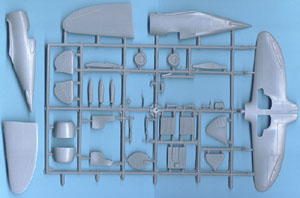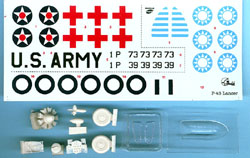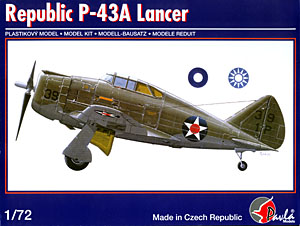Pavla’s 1/72 Republic
P-43A Lancer | | History As the first all-metal monoplane fighter Alexander Kartveli’s Seversky P-35 was a big step forward for the U.S. Army Air Corps. The P-35 also was the first closed-cockpit fighter and the first retractable landing gear-equipped fighter is USAAC service, but Kartveli thought that refining the basic P-35 shape and using a bigger engine with a turbosupercharger would result in a real winner. He was right. However, that plane was the P-47 Thunderbolt. In between the P-35 and P-47 came the P-43 Lancer, with an R-1830-35 Twin Wasp radial in its nose, two .30 and two .50-caliber machine guns, and a distinct family resemblance to its predecessor and successor. With a top speed of 355 mph, it topped the P-35 by 45 mph, but it was fairly clear that the P-47 on the boards was a superior machine. The 272 P-43s were manufactured mostly to keep workers around until the P-47 was ready to hit the assembly line. The P-43 did see action, however. About 180 were sent to China, and 17 P-43A-1 reconnaissance versions were sent to Australia.  The Kit The Kit
Pavla’s kit combines short-run molding with some very nice resin bits and good decals to yield an eminently buildable Lancer. The cockpit is somewhat rudimentary, despite an absolutely beautiful resin seat, frame and seat belts. There is no sidewall detail, and the control stick and floorboards are molded with little definition to their details. The control panel is resin and is of a very funky shape--be careful not to mistake the rudder pedals for flash and cut them off! The surface detail is quite nice, represented by petite scribed lines. The cockpit mounts conventionally inside the fuselage before it is sealed, as does a resin supercharger head. My piece was a little out of round and needs sanding. The vertical and horizontal tails are single pieces and butt-join the fuselage. Pavla calls out the three-degree offset of the vertical tail in the instructions. Two bulkheads and two ribbed plates provide a start at boxing in the wheel wells, although the modeler will have to do a little work to complete the job. A two-piece cowling, which gets two machine gun blisters, surrounds the resin engine; the propeller is a resin hub with plastic blades. The front of this model is easily its most complex area. The main wheels are provided both in plastic and in resin, though the latter suffer from the “flat tire” syndrome, something a little sandpaper can cure. Main struts are provided, but the retraction struts need to be made from styrene rod. The instructions also advise the modeler to make anti-torque scissors; I’ll just raid my spare photoetched brass details for these. The supercharger shaft fits neatly into a insert in the lower wing.  The clear parts are vacuformed; this may cause a bit of fuss when fitting the side windows. The canopy itself is quite clear. You get one canopy, so take care if you want to cut it open to display the cockpit. The clear parts are vacuformed; this may cause a bit of fuss when fitting the side windows. The canopy itself is quite clear. You get one canopy, so take care if you want to cut it open to display the cockpit.
Four decal schemes are provided. These include two USAAC 1st Pursuit Group P-43s, with red crosses that let you choose to model them either at their Selfridge Field, Michigan home base or as “Red Party” fighters from the Carolina wargames of 1940. In an identical olive drab-over-neutral gray scheme is a Chinese machine from the 4th Pursuit Group, CAF. The final scheme is more colorful, an RAAF recon Lancer from the 1st Photo-Reconnaissance Unit (PRU). This machine is finished in a foliage green/earth brown/sky blue camouflage, with the blue and white roundels in six locations. The decals are well printed, although the Chinese roundels and stripes seem a little light in color. Conclusion
I know people who have struggled through vacuform kits of this subject
and they will be overjoyed to see an easier option in Pavla’s kit. Though
still not the ideal first short-run kit, with its make-them-yourself details
and complex cowling arrangement, it might make a very good second or third
model.
EXTRA--Reader and modeler extroardinare Ben Guenther is building this
kit, and he spotted one problem that modelers may want to fix. The Pavla
kit provides a two-bank, 18-cylinder engine. In reality, the P-43 had
a 14-cylinder R-1830. Ben has also found that the landing gear struts
are too short; he's substituted struts from the Revell P-47M kit, and
used True Details wheels to replace the kit items. Thanks for your input,
Ben!
| 


 




    |
